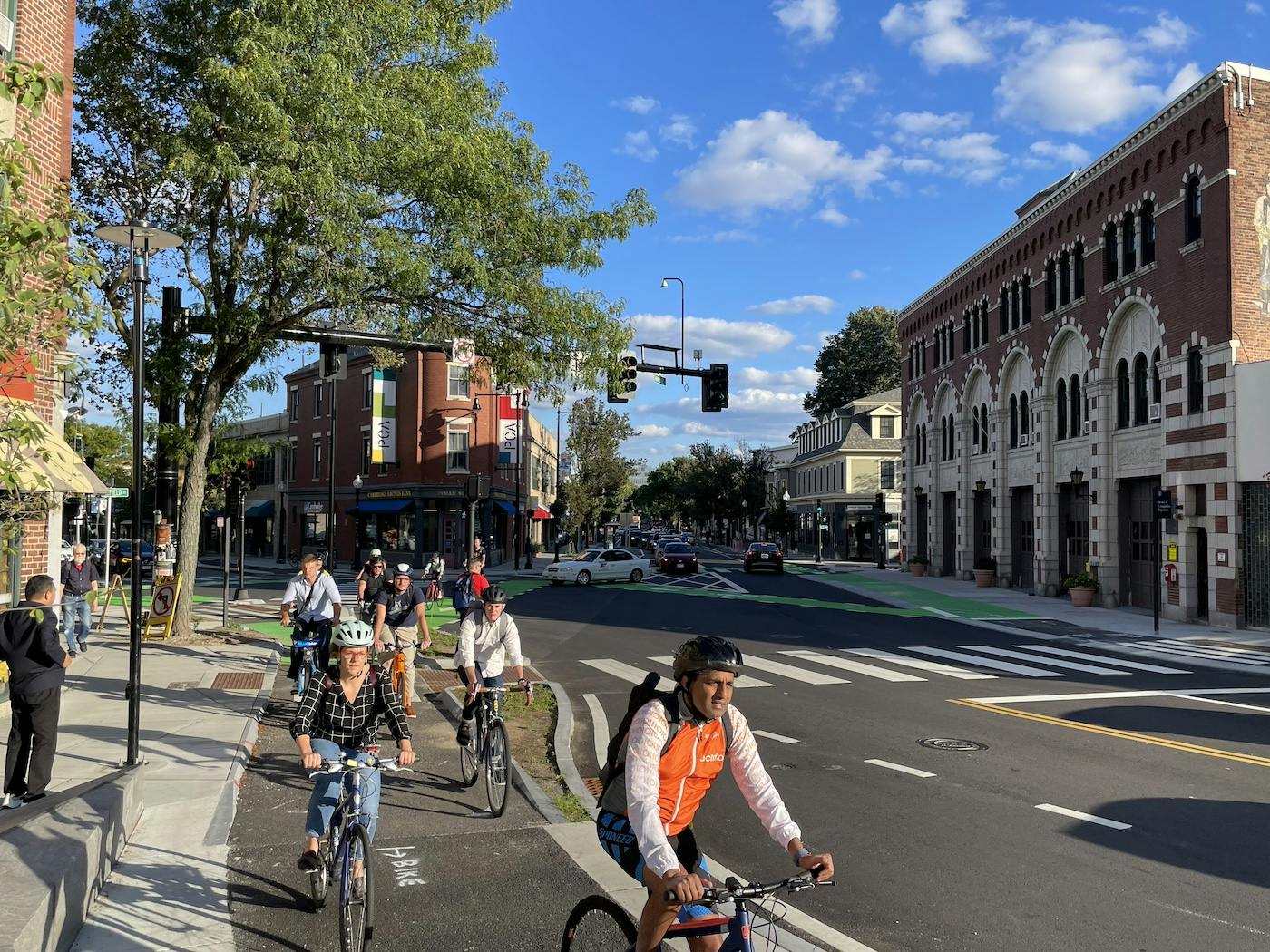How Pro-Bike Policies Transformed Cambridge, Massachusetts, Into a Top City for Biking
By: Jack Foersterling, editorial content manager

As one of our 2024 Cities on the Rise, building better bike infrastructure isn’t just the norm in Cambridge, it's the law.
Bicyclists enjoy the newly redesigned Inman Square. Photo Credit: City of Cambridge
With the release of our seventh annual City Ratings, featuring 2,300 U.S. cities for 2024, PeopleForBikes is celebrating cities that have dedicated work in recent years to improve their scores and make biking better in their communities.
Cambridge, Massachusetts, is one of our 2024 Cities on the Rise, scoring a tremendous 72 out of a possible 100 in this year’s ratings. This year, they rank #2 out of 604 medium-sized U.S. cities for bicycling.
In 2019, Cambridge City Council passed the Cycling Safety Ordinance (CSO), one of the strongest Complete Streets ordinances in the nation, requiring the city to construct separated bike lanes when streets are reconstructed. Since then, bike infrastructure has popped up all across the city, thanks in large part to their quick-build projects that create separated bike lanes without the major time or funding investment of other infrastructure improvements. But Cambridge’s commitment to better bicycling started well before the CSO.
“The backbone of our work really started in the early 1990s with our Vehicle Trip Reduction Ordinance,” says Cara Seiderman, the transportation program manager for the City of Cambridge. “The ordinance was voted on by the city council and said we were going to reduce single occupancy vehicle trips through the promotion of walk, bike, and transit trips.”
Seiderman says a slew of other city policies also work toward that same goal — the city’s climate action plan supports active transportation, the Cambridge Growth Policy includes provisions for walking and biking infrastructure, and even the Cambridge Public Schools District Plan looks to help more students safely bike to school.
With multiple policies supporting bicycling as a form of transportation in the city, bike infrastructure grew, and so did the number of people bicycling. The City of Cambridge’s website includes an interactive map and data table showing the evolution of the city's bike network alongside bicycle counter data dating back 20 years.
Seiderman also points to the city’s Vision Zero policy as a major step forward, which was unanimously adopted by the Cambridge City Council in 2016. One of the main outcomes of the initiative was the reduction of speed limits throughout the city, with most streets now having a 20 mile per hour speed limit with major streets only being 25 miles per hour.
One major recent project highlighting Cambridge’s dedication to better and safer bicycling is the redesign of Inman Square, named one of PeopleForBikes’ Best New Bikes Lanes of 2023.
“Inman Square is an extremely complicated intersection, with seven different streets coming into one area. Before, it was hard to traverse by any means — car, bike, bus, or walking. But it is also one of the highest traveled corridors by bike in the Northeast,” says Seiderman. “It was the biggest transformation of any corridor in the city. It became a really beautiful public space that people flock to, not just walk through.”

A separated bike lane in the newly redesigned Inman Square. Photo Credit: City of Cambridge
A testament to the quality of work Cambridge put in, a video clip of the redesigned Inman Square went viral on social media after a local jokingly claimed the newly built bike lanes he was riding were in the Netherlands.
But Cambridge’s efforts to improve bicycling go beyond just infrastructure projects, with a large emphasis placed on youth riding in the city.
“Like many places, we have Safe Routes to School. In first and second grade, students are introduced to general traffic safety, followed by a learn to ride program in fourth grade,” says Seiderman. “In middle school, there’s a biking on the streets program that teaches students how to safely travel around the city by bike. For high schoolers, 16 year olds can get really cheap passes for our Blue Bike bike share program.”
So, what can your city learn from Cambridge? According to Seiderman, you don’t have to think that far outside of the box.
“If a place is starting from the beginning, you don’t have to reinvent the wheel. There are tried and true ways of creating good bicycling environments,” she says. “Incorporating good bicycling facilities that serve people of all ages and abilities should be assumed. Everyone deserves to have a safe place to walk and ride a bike. And when good bicycle infrastructure and facilities are created, people will choose to bike more.”
For local advocates, Seiderman’s point about making sure all members of the community feel safe using the infrastructure hits the nail right on the head.
“One concept that I lead with when speaking to city council is mobility justice — that all people should feel safe using our streets,” says Clyve Lawrence, a strategy team member with the local advocacy group Cambridge Bike Safety. “Bike lanes are helpful for our communities. When we build bike lanes in areas that were previously only seen as safe or comfortable for white men to ride in, we’ll get those other groups on bikes. Don’t be afraid of pushing the status quo and leaning into the idea that bicycling and multimodal transportation can and should be equitable.”
Related Topics:
